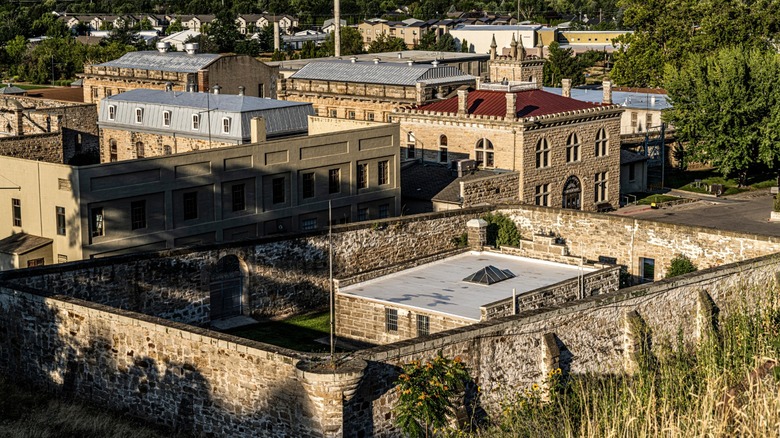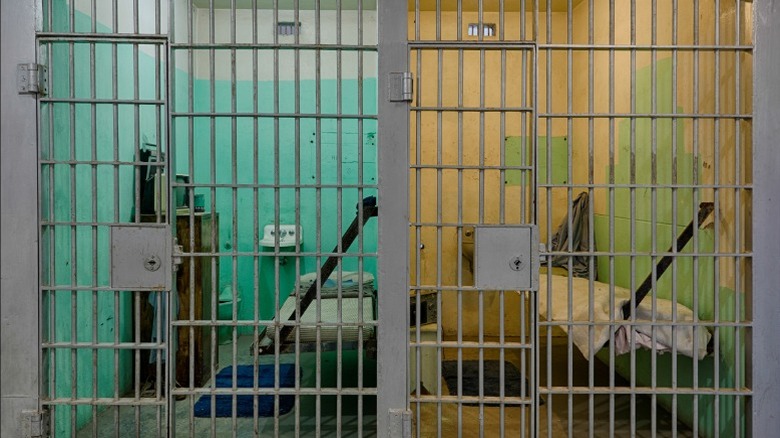One Of Only Four Territorial Prisons Open To The Public Is An Eerie Idaho Attraction With A Notorious History
You wake up unbearably cold, with no heating to ease the frigidity of Boise's severe winter, sealed in by sandstone walls. It's stifling, especially with a terrible cough and bad ventilation. Your cell hasn't been cleaned in almost a month, and the communal "honey pot" for waste is full from the previous day. You work in the shirt, shoe, or license plate factory, at the bakery, or on backbreaking road construction. The next day, you do it all again. And again — until your time is up, whether by release, at the gallows with nine others, or by other gruesome ends.
This was life at the Old Idaho Penitentiary, now one of only four American territorial prisons open to the public. Notorious for its harsh conditions, the site remains chilling because it looks as much as it did when vacated in 1973, from graffiti to ruins left by a major fire. Considered one of the state's most haunted places, the "Old Pen" is more than a macabre museum drawing history buffs, paranormal enthusiasts, and curious tourists. It's a symbol of Boise's transformation from frontier town to state capital. Opened in 1872 to hold gold rush outlaws, the prison expanded over the decades — often beyond capacity — as Idaho's population and crime rate grew. It housed all types of felons, including violent murderers.
The prison began with a single cell house on 4 acres, ringed by a wooden fence. Inmates quarried yellow sandstone from the nearby Table Rock foothills to build its fortresslike administration building and 17-foot-high wall with guard turrets. Its rusticated Romanesque cell blocks — deliberately designed to feel "somber" and oppressive — reflect the grim penal conditions of the times, a stark contrast to Boise today, a lively college city that's one of the best places to retire in America.
Old Idaho Penitentiary is an eerie attraction with a notorious history
Listed on the National Register of Historical Places since 1974, the former territorial prison grew to 500 acres with more than 40 buildings. The museum site spans just 4.5 acres, but offers a detailed look at prison life, inmate biographies, and the architecture that defined the compound. Permanent exhibits invite reflection, including "Faces of the Idaho State Penitentiary," which examines inmate diversity and the facility's history of religious persecution and discrimination. "Disturbing Justice," featuring more than 60 illustrations by local artists, challenges conventional definitions of the justice system. Explore at your own pace, or pay $2 more for tours led by knowledgeable docents.
Like Old City Jail, Charleston's most haunted building, the Old Pen carries the weight of lingering spirits tied to the trauma and fear that transpired within. Atrocities included solitary confinements in "The Dungeon," a 4-foot cube underground, and "Siberia" a 3-by-8 foot cell without light, plumbing, or water, where at least one inmate died. These brutal conditions, paired with deteriorating facilities, drove many prisoners to suicide and incited riots. Three people died during a 1971 incident, and another in 1973 led to the penitentiary's closure. Paranormal investigators and shows from "Ghost Adventures" to "The Lowe Files" have captured eerie sights and sounds, including in the death chamber where "Idaho's Jack The Ripper," Raymond Snowden, slowly suffocated during a botched hanging. Visitors still report hearing his gasps, along with voices, apparitions, cold spots, and slamming cell doors, cementing its reputation as one of the most haunted places in America.
On a lighter note, Old Pen hosts colorful events showcasing history and Boise's culture, from film screenings and art shows to Yoga in the Yard and simulated overnight stays, honoring the past while bringing the community together.

